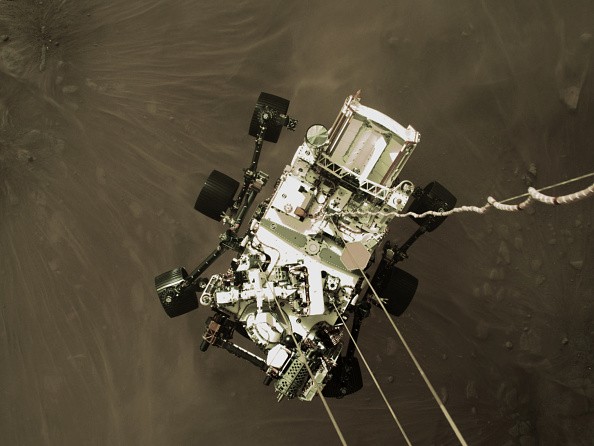NASA Perseverance Rover is still having a hard time observing the plains of Mars. Can NASA still use the MEDA sensor?

(Photo : Photo by NASA via Getty Images)
In this handout image provided by NASA, still image is part of a video taken by several cameras aboard the descent stage as NASA’s Perseverance rover as it touched down in the area known as Jezero crater on February 18, 2021 on the planet Mars. A key objective for Perseverance's mission on Mars is astrobiology, including the search for signs of ancient microbial life.
Since the Red Planet has a very harsh environment, the international space agency faces various issues that affect its efficiency.
Although this is the case, the Perseverance Rover can still send essential information, as well as images of the Mars plains.
But, this time, NASA's space vehicle suffered a little serious damage after its MEDA (Mars Environmental Dynamics Analyzer) sensor got hit by some rocks.
However, MEDA is still working since only one of its sensors was damaged.
NASA Perseverance Rover's MEDA Sensor Damaged by Mars Rocks
According to Space.Com's latest report, MEDA is one of the instruments carried by NASA's Martian vehicle when it landed on the Red Planet back in February 2021.

(Photo : Photo illustration by NASA via Getty Images)
In this concept illustration provided by NASA, NASA's Ingenuity Mars Helicopter stands on the Red Planet's surface as NASA's Mars 2020 Perseverance rover (partially visible on the left) rolls away. NASA's Perseverance (Mars 2020) rover will store rock and soil samples in sealed tubes on the planet's surface for future missions to retrieve in the area known as Jezero crater on the planet Mars.
Also Read: NASA James Webb: Deeper Photos of the Universe to Come This July-What to Expect?
MEDA relies on two sensors to observe the speed of the wind. However, one of them is now damaged. Despite getting hit by some Martian pebbles, MEDA's Principal Investigator Jose Antonio Rodriguez said that NASA can still use the equipment.
"Right now, the sensor is diminished in its capabilities, but it still provides speed and direction magnitudes. The whole team is now re-tuning the retrieval procedure to get more accuracy from the undamaged detector readings," he explained.
Rodriguez added that they weren't able to predict the strong winds that led to the MEDA damage, although they already have experience in this kind of scenario.
He even jokingly said that it is ironic that the wind sensor was damaged by wind. As of writing, NASA is still checking eh overall damage caused by the Mars rocks.
How Strong is Mars Wind?
Air and Space explained that Mars has a thin atmosphere compared to Earth. Because of this, the Red Planet usually experiences strong gusts of wind.
Experts estimated that Mars usually has winds moving at around 16 to 32 kilometers per hour. This speed is already the same as a car driving on an open road.
Now, imagine that you get hit by a rock carried by the wind at 32 kilometers per hour. If you want to see more details about Mars wind, you can visit this link.
On the other hand, the NASA DART mission is now expected to deform a tiny moon in the solar system.
Meanwhile, NASA's Curiosity Rover acquired new evidence that Mars is really habitable.
For more news updates about the NASA Perseverance Rover and its experiences on Mars, always keep your tabs open here at TechTimes.
Related Article: NASA Perseverance Rover Troubled by Mars Rocks; Operators Say It's Difficult To Find the Right Samples
This article is owned by TechTimes
Written by: Griffin Davis








